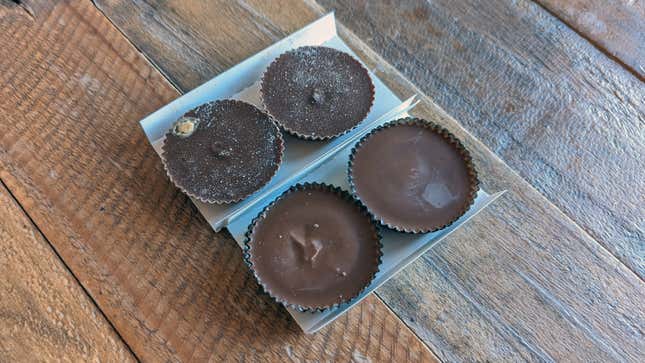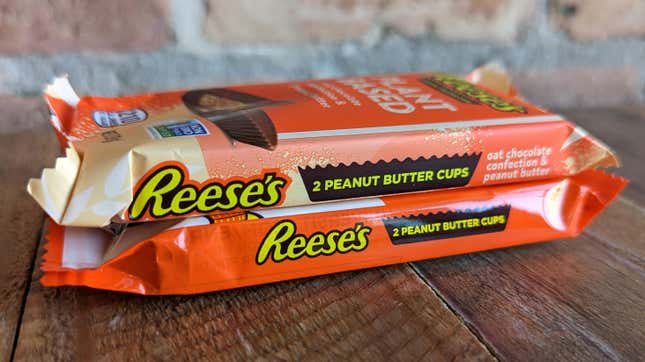As I sit here, typing away, I’m distracted by a persistent candy-sweet smell wafting upward from the surface of my desk, hitting my nostrils from a distance of about three feet. On my desk sit two Reese’s Peanut Butter Cups, one classic and one Plant Based. I do a side-by-side comparison, lifting each to my nose in turn. Sure enough, the fragrance is coming entirely from the Plant Based cup, its dusty oat milk notes covering any trace of the peanut butter within.
Reese’s Plant Based Peanut Butter Cups, explained
The world, it seems, has been waiting for a dairy-free Reese’s Peanut Butter Cup to hit shelves; last week’s announcement by The Hershey Company was met with tons of buzz and excitement from the likes of PETA, TikTok influencers, and the late night talk show circuit.
“Our purpose is to create more moments of goodness for consumers,” Teal Liu, brand manager for Hershey’s Better For You division, said in the press release. “Those moments are now more accessible for chocolate lovers looking for plant-based alternatives.”

It’s an undeniably good thing that America’s top chocolate producer is investing in products that more consumers can partake in; those with vegan diets, dairy allergies, or any other reason to abstain from milk chocolate can now drop $2.50 on a pair of Reese’s Plant Based Peanut Butter Cups, roughly a dollar more than the classic version. And right now is the perfect moment for Hershey to unleash its oat-milk-forward confections, since oat milk has seen a huge spike in sales over the past two years, overtaking several other alternative milks to sit only behind soy in the plant-based milk category.
So, it’s an undeniably savvy move. But is it a delicious one?
How do Reese’s Plant Based Peanut Butter Cups taste?
A classic Reese’s Peanut Butter Cup is made by pouring milk chocolate into waxy paper cups on the factory line, and when you take a bite, your teeth sink right in, evoking the creaminess of the melted chocolate that formed it. The Plant Based cup feels immediately more rigid, and you can tell before you even take a bite—its biggest tell is that it doesn’t have any cup liner to speak of, meaning it never needed any assistance in holding its shape. Its ridges and edges, therefore, are visibly more uniform.

Taking a bite of a Reese’s Plant Based cup is exactly the same feeling as snapping off a bite of a dark chocolate bar. The thick, sturdy chocolate around the edges begs to be offset by the peanut butter inside, so the chocolate-filled first bite is the worst. There’s a substantial amount of peanut butter filling, but it doesn’t go out toward the edges as much as in a classic Reese’s; this might have something to do with the way they’re molded vs. poured.
Without dairy, what you miss in a Plant Based cup is the “goo factor” that makes so much chocolate candy so much fun. Whereas biting the center of a classic Reese’s will cause the peanut butter and chocolate to fuse as one, the Plant Based cup’s layers remain stubbornly distinct. On the plus side, the rigidity of the oat milk chocolate means less melting in your hands. Unfortunately, it means a little less melting in your mouth, too.
If you genuintely, uncomplicatedly love the taste of oat milk, you’ll find that the chocolate almost over-delivers on that flavor. However, even as someone who loves oatmeal, overnight oats, and oat milk lattes, I have to say that in this context, the abundance of oat flavor lends a dusty, cardboard note to the chocolate that crowds out the peanut butter flavor.

This all might just be a ratio problem. If this candy’s thick edges and solid walls of oat milk chocolate were thinned out just a bit, it might help minimize the blaring difference between the Plant Based chocolate and the milk chocolate it’s trying to imitate. As it stands, though, this product has the inadvertent effect of highlighting just how delicious the original formula has always been.
Should you buy Reese’s Plant Based Peanut Butter Cups?
There is great dairy-free chocolate out there; plenty of brands have worked to get it right, and many surpass their dairy-filled equivalents. This new Reese’s peanut butter cup is not an example of a vegan product that outshines the original—but with a few tweaks, it could certainly be on par with it.
Ultimately, though, what I think of Reese’s new foray into vegan confections is not what The Hershey Company is concerned with. Instead, the product is an expansion into an untapped market, a group of dairy-free consumers that has been courted almost exclusively by gourmet brands as mass-market producers have been much slower to adapt. If you’re a plant-based consumer, you’ve likely endured a long and frustrating wait. To you, this peanut butter cup might taste like victory at last. To me, it tastes a little more like a first draft of something great.

